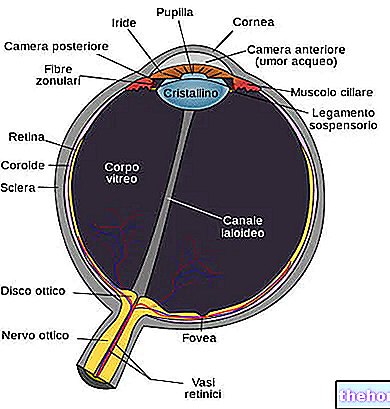What are ophthalmic ointments
Ophthalmic ointments are pharmaceutical preparations that are applied directly into the eye to treat or improve a specific eye condition.
Similarly to eye drops, ophthalmic ointments are also indicated in the treatment of all superficial inflammations at the ocular level, including those of infectious and allergic origin.
The drugs formulated in the form of ophthalmic ointment make the administration of the active principle extremely easy even if, as we will see, the application of the substance in the eye can cause a temporary blurring of vision, burning and redness.
Indications
Based on the active ingredient contained in them, ophthalmic ointments are indicated for the treatment of:
- Blepharitis: generic inflammation of the free edge of the eyelid
- Keratitis: inflammation of the cornea
- Allergic conjunctivitis: inflammation of the conjunctiva caused by allergic reactions
- Bacterial conjunctivitis: inflammatory process (inflammation) of the conjunctiva related to bacterial insults
- Viral conjunctivitis: inflammation of the conjunctiva dependent on viral infections
- Glaucoma: a subtle pathological condition characterized by an increase in intraocular pressure. When not treated in time, it can lead to blindness.
- Eyelid irritation (generic): may be due to infection, trauma or the presence of a foreign body in the eye
- Sty: inflammation of the sebaceous glands at the level of the eyelashes
- Dry eye (dry eye syndrome)
- Corneal ulcers: severe lesions induced by a corneal infection
- Uveitis: inflammation involving the uveal tract, consisting of the iris, choroid and ciliary body.
How to use
Although it is quite simple, the application of the ophthalmic ointment still requires a certain precision and delicacy from the hand of the person performing the maneuver.

Before proceeding with the application, it is essential to wash the hands, which must be carried out with particular care to prevent germs or dirt particles from passing from the skin of the hands to the eye.
After making sure that the product is in perfect condition and has not expired, open the ophthalmic ointment, taking care to place the cap on the side where it is not closed ("up") on a table to avoid possible contamination.
By slightly tilting the head backwards and directing the gaze upwards, with the help of the thumb (or index finger), the lower lid of the eye where the ointment is to be administered is gently lowered. At this point, squeeze the tube with the thumb and middle finger of the other hand: indicatively, let 1 cm of product come out in the conjunctival sac, that sort of pocket that originates under the lower eyelid, and offers a sliding surface for the eyeball.
After applying the ointment, gently close the eyelids; to facilitate the distribution of the product, it is advisable to roll the eyes under the eyelids.
If possible, avoid squinting your eyes hard to keep the ointment from coming out.
Did you know that ...
To prevent the ointment from coming out after releasing the lower eyelid, the advice is to gently grasp the upper eyelid (of the eye in which it is applied), lifting it with equal care until the eyelid margins are juxtaposed.
To prolong the contact time between the ophthalmic ointment and the eye, it is possible to proceed with an occlusive dressing.
After application, close the container tightly.
Throw the ointment tube into the trash after the treatment cycle.
The dosage (daily frequency of application and duration of therapy) depends on the ocular disorder to be treated.
Warnings and recommendations
Before applying the product to the eye, always inform the doctor of the symptoms and any allergies (ascertained or presumed) to drugs and other substances. It is also necessary to report any medications that are being used - in particular those for ophthalmic use - to avoid the risk of drug interactions.
To preserve the integrity and efficacy of the product, it is recommended to keep the tube of ophthalmic ointment in a cool and dry place, away from light (unless otherwise indicated in the package leaflet).
The ophthalmic ointment, like any type of drug, must be used at the right dosage (dosage), respecting to the letter the instructions provided by the doctor or pharmacist. When used improperly, ophthalmic ointments - especially antibiotic ones - they can give rise to sensitization phenomena.
Particular attention in the use of these pharmacological preparations must be paid by pregnant women: some active ingredients contained in the product could harm the health of the unborn child. For this reason, it is recommended to always report any pregnancy (even if presumed) to the doctor.
Once the product has been opened, it is good practice to check the validity of the drug (expiration date): some ophthalmic ointments, in particular those intended for the treatment of ocular infections, lose their therapeutic efficacy after 5-7 days from opening.
It is recommended not to use the same ointment tube for several people.
Keep the product out of the reach of children.
Advantages and disadvantages
In a sense, eye ointments are more beneficial than eye drops because the pharmaceutical formulation allows the active ingredient to stay in contact with the conjunctiva for longer periods.
However, eye ointments are not always considered excellent substitutes for common eye drops: this is because the ointment formulations have the disadvantage of creating a blurred vision which, although transient, can induce considerable discomfort.
For this reason, many doctors recommend preferring eye drops during the day and using eye ointments in the evening before bed.
The transient blurring of vision is the most important limit of application of ophthalmic ointments.
In addition to blurred vision, the use of ophthalmic ointments can induce other unwelcome side effects, such as in particular:
- Eye redness
- Abundant initial tearing
- Sensitization reactions
- Sensation of ocular burning
Immediately report any other side effects or worsening of symptoms following the application of the ophthalmic ointment to the doctor.

-a-cosa-serve.jpg)


























